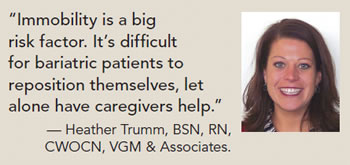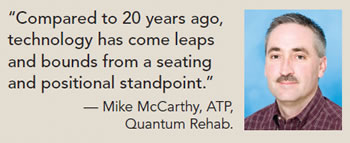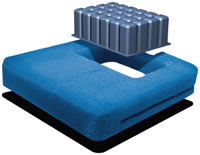Problem Solvers
Staying Safely Seated
Understanding bariatric wound care issues and why cushions are important treatment tools.
- By Joseph Duffy
- Aug 01, 2010
With obesity permeating 34 percent of U.S. adults, wound care issues in bariatric patients are of high concern. According to a recent survey released jointly by Trust for America’s Health and the Robert Wood Johnson Foundation, in 1991, no state had an obesity rate above 20 percent; today, 38 states report adult obesity rates over 25 percent.
But the real shocker is it’s not just an adult epidemic anymore: Nearly one in three children and teens are overweight and obese. And studies show that obese children typically grow into obese adults.
In response to this alarming survey, HME Business spoke with three experts on wound care issues in bariatric patients and what providers need to know, including how cushions aid in the treatment of these wounds.
Common wound care issues in bariatric patients
“The bariatric population has wound care issues with pressure ulcer development in the bony prominence areas secondary to increased weight,” says Heather Trumm, BSN, RN, CWOCN, Director of Wound Care and Bariatrics for VGM & Associates “They also may develop pressure ulcers in atypical areas of the body such as in-between skin folds, in the hip area from immobility, and pressure ulcer development from tubes and catheters.
“This population also has problems breathing when lying down; therefore, they would rather sit up in bed or in a chair,” she continues. “There is increased pressure to their sacral and coccyx areas when sitting up, which increases their risk for developing pressure ulcers in those areas. Bariatric patients are also at higher risk of developing chronic wounds such as venous ulcers and diabetic foot wounds due to their co-morbidities and poor circulation. Bariatric patients also face the issue of development of fungal and bacterial infections. Bugs thrive in dark, moist environments, such as in between skin folds.”
Trumm also points out that bariatric patient nourishment can be an issue. Many times this population is not getting the needed protein, vitamins and minerals that their body needs to aid in wound healing. Without the proper protein, vitamins and nutrients, wound healing is delayed.
When compared to other populations, the bariatric population, as a whole, doesn’t have specific wound care treatment issues, says Christin Krey, MPT, ATP, of Shriners Hospitals for Children in Philadelphia. “But the causes, as compared to the nonbariatric population, might be different in that with the bariatric population there is excessive redundant tissue so you may have more wounds located within skin folds where tissue is sitting on top of each other causing breakdown from moisture and friction and sheer.”
She says the bariatric population might be at an increased risk because of a more sedentary lifestyle. It’s more difficult to move, they are sitting more often and they have decreased mobility overall.

“Immobility is a big risk factor,” Trumm says. “It’s difficult for bariatric patients to reposition themselves, let alone have caregivers help because of their weight. Repositioning is needed to prevent the development of pressure ulcers and in the bariatric population; it’s more difficult to do.
“Moisture, shear and friction are risk factors in the development of pressure ulcers. Bariatric patients have a larger body mass to skin ratio and this leads to increased perspiration and difficulty controlling body temperature. Bariatric patients perspire more and when this happens in between their skin folds, it can lead to fungal infections and contribute to irritation that may lead to pressure ulcers.
“Bariatric patients also have more difficulty with urinary issues because of the increased intra-abdominal pressure secondary to the adipose tissue.” Bariatric patients may share many of the risk factors of other non-bariatric immobile populations, but when it comes to healing, there are different challenges.
“The reason that bariatric individuals have a more difficult time healing is due to their skin-weight ratio, changes in skin physiology and reduced vascularity and perfusion from adipose tissue,” Trumm says. “Adipose tissue is avascular (lacking blood supply) and for a wound to heal, it needs good blood flow to the wound to get it the needed oxygen and nutrients it needs to heal. Adipose tissue also has a decreased ability to fight infection, which may delay healing.” According to Trumm, wounds in bariatric patients are typically from:
- Pressure ulcer formation from immobility.
- Pressure ulcer formation from improper fitting of equipment, such as wheelchairs.
- Pressure ulcer formation in-between skin folds from chaffing and moisture.
- Wound dehiscence (a wound is surgically closed by sutures and reopens from the excessive tension on the sutures).
- Venous insufficiency — the blood can get down to the lower extremities, but has a difficult time going back up to the heart.
- Arterial insufficiency — the arteries are damaged and therefore have trouble getting to the lower extremities.
- Diabetic or neuropathic wounds.
So how do you prevent and treat wound care issues in bariatric patients? Trumm offers the following:
- Carefully monitor high-risk areas such as the perineal area, skin folds, sacrum, heels, Ischial tuberosities, occiput and pannus.
- When transferring these individuals, do not cause shear or friction to their skin.
- Make sure they are well nourished and hydrated. A misconception of bariatric patients is that they are over-nourished. The fact is that many of them are undernourished because they are eating the wrong types of food and not enough protein.
- Make sure they are getting the needed personal hygiene such as keeping their skin folds and perineal area dry and free of fungus.
- Have the patient fitted for appropriate medical equipment such as wheelchairs, commodes, walkers and beds.
- Collaborate with a multidisciplinary team and get all medical personnel involved with their care: Physician, dietician, nurses, physical therapists, occupational therapist, psychologists, pharmacists and equipment suppliers.
“The ultimate goal to treatment,” Krey says, “is to unload the area that has pressure. But realistically speaking, that is not always possible.” There are many product categories available to help manage the interface (where body meets surface) and unload that pressure. One of the critical tools used by healthcare providers to help in the prevention and treatment of wound care in bariatric patients is the cushion.
Cushion use in the bariatric population
“Compared to 20 years ago, technology has come leaps and bounds from a seating and positional standpoint,” says Mike McCarthy, ATP, Quantum Rehab’s National Sales Manager of Manual Wheelchairs and Synergy Seating Products. “Technology has come full circle with varying types of products, varying types of cushions for all product segments but bariatrics specifically.’
From a seating and positioning standpoint, McCarthy says there are two different demographics: The bariatric population that can ambulate parttime and the bariatric population that sits full-time. And those different populations need very different applications and different technologies.
“Our pressure relieving cushion, which we’ve had success with, is our Synergy Spectrum Air, which is being used quite frequently in the bariatric population,” McCarthy says. “Our SIL-AIR Technology has done great things for the bariatric population. And that application would be for that nonambulatory demographic. As we look to the part-time ambulatory population, you may look for a high resiliency foam or a gel-type application.”

An exclusive technology of Quantum Rehab, the SIL-AIR is a silicone impregnated reticulated foam that, according to McCarthy, “does wonders for heat reduction at the interface. It helps reduce skin temperature, allows for air circulation and can be customized to meet many different types of consumer needs.”
Somebody who is seated on a foam or gel surface would be a part-time ambulatory or somebody who sits only a couple of hours per day, says McCarthy. An air or dry floatation application is for somebody who sits all the time.
“You use the different types of products for pressure distribution, for decreasing excessive pressure, but then also you consider sheer reduction, moisture reduction and temperature reduction at the interface where the client meets the cushion,” Krey says. “So you want to think about something that might allow for greater air circulation and moisture if they are going to be seated for a long period of time.”
Typically, patients are directed by either their physician or another healthcare professional to use a cushion (or another pressure-relieving product). But ideally, says Krey, the situation will be a joint effort between the DME provider, the clinician, most likely a therapist doing wheelchair seating evaluation, and the physician doing a full evaluation — medical history, taking measurements, looking at positioning and posture — and then based on all the information that’s collected, provide the patient with options that best meet their needs.
According to McCarthy, Medicare covers cushions, but he refers partner providers to consult with their local DME and their medical policy for coverage criteria. Typically, he says, it breaks out into five areas:
- General use.
- Skin protection.
- Positioning.
- Skin protection and positioning.
- Adjustable skin protection and positioning.
There are criteria that have to be met in each one of those categories and they are diagnoses driven. In other words, in order for a seat cushion to be covered the consumer would have to meet those criteria that fall within that category.
Finally, the key for providers to helping bariatric patients with wound care issues is asking the right questions up front.
“If you want to have an extremely positive outcome, you have to have the more pertinent medical questions answered,” McCarthy says. “As it relates to cushions, that question would be the obvious one: Have there ever been skin integrity issues that we need to know about? If you know that you’re dealing with somebody who has had integrity issues, whether it be secondary to a surgical intervention five years ago or a nutritional issue where their skin is not as viable, the provider can make an extremely good call and provide a very applicable product if they have that information up front.”

Cushions such as Quantum Rehab’s Synergy Spectrum help prevent wounds by providing a support surface that minimizes shear and moisture. The Spectrum cushion can support up to 650 lbs. and features a high density molded foam base, a viscoelastic top layer, an inner liner for incontinence and to reduce shear, a moisture wicking fourway stretch cover, and a standard 3 mm ACM solid seat insert.
This article originally appeared in the August 2010 issue of HME Business.